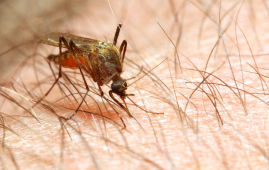

If you have diabetes, you may want to be cautious about taking care of simple cuts, scratches, scrapes and bruises, even if they seem minor. In fact, skin care of any kind is important to your health.
Dermatologist Christine Poblete-Lopez, MD, says bruises are the simplest to address if you have diabetes. As long as the skin is not broken, you really don’t need to do much of anything, except keep an eye on the area.
“A bruise is a bruise, and it will act like a bruise and go through the different changes in color over time,” says Dr. Poblete-Lopez. “So being diabetic does not necessarily mean it will lengthen the way a bruise will resolve or not.”
If you have any type of laceration, however, you should keep a keen watch for infections because people with diabetes are more prone to developing infections, according to Dr. Poblete-Lopez. Some signs of infection to look for are:
- Redness.
- Warmth.
- Tenderness.
- Pus drainage.
“If you have any of those signs, you definitely need to bring it to the attention of your doctor, because you may need oral antibiotics,” she says.
A diabetes specialist’s approach
There are some differences of opinion among diabetes experts and dermatologists when it comes to healing wounds. Diabetes specialist Leann Olansky, MD, says when cleaning out a cut, for example, begin by washing it with soap and water. Then add an over-the-counter topical antibiotic such as Neosporin or a prescription ointment such as Bactroban to help prevent bacteria from entering into your subcutaneous tissue.
The next step, says Dr. Olansky, is to cover the cut with a bandage to keep it moist so that it will heal faster.
“I don’t think there’s any advantage to keeping it open to the air,” Dr. Olansky says. “If the edge of a laceration gets dry, those cells dry, and you’re better off keeping a laceration, cut or a scrape moist with a topical antibiotic until you get a a scab that provides the same kind of protection as your skin.”
She does warn that some people may be allergic to the active ingredients, neomycin and bacitracin, in the topical ointments and can develop contact dermatitis. She also adds that if it’s a deep cut and you haven’t had a tetanus shot in five years, you should ask your doctor about whether you should have a tetanus shot.
Additionally, Dr. Olansky advises that, if you have diabetes, you should be especially careful with any cuts on your feet, so that you prevent any possible progression to other, more serious problems.
A dermatologist’s approach
There are different schools of thought about using hydrogen peroxide to clean out cuts or wounds. Because peroxide can damage new skin cells while they’re growing back, Dr. Olansky prefers patients use soap and water rather than peroxide.
But Dr. Poblete-Lopez, recommends using peroxide because it does such a good job of preventing infections. It may depend on your condition and the severity of the wound, so it’s important to talk to your own physician.
Both doctors see a risk for contact dermatitis in topical ointments and creams, though to Dr. Poblete-Lopez, the risk is enough of a concern to recommend that patients avoid using them altogether.
Here is what Dr. Poblete-Lopez recommends for cleaning and caring for a cut or scrape:
Apply a mix of half peroxide, half water to an ear swab applicator or piece of gauze to clean it and pat it dry,
Then apply petroleum jelly twice a day, to keep it moist and allow the skin cells to migrate and close up the wound.
If it’s a cut with sutures, then use plain, undiluted hydrogen peroxide.
She adds that, contrary to popular belief, dermatologists typically don’t like wounds to develop scabs, since they can delay the healing process.
“We know that scabs impede the migration of skin cells as part of healing,” she says. “So by keeping it moist, you can keep the scabs off until the cut heals.”
Ultimately, how you heal depends on your specific medical history and diabetes, as well as the severity and type of wound you are treating. So, you should work with your own doctor to figure out what works best and is safest for you.
more recommended stories
 Circadian Control of Neutrophils in Myocardial Infarction
Circadian Control of Neutrophils in Myocardial InfarctionKey Takeaways for HCPs Neutrophil activity.
 E-Cigarette Use and Heart Attack Risk in Former Smokers
E-Cigarette Use and Heart Attack Risk in Former SmokersKey Takeaways for Clinicians and Nurses.
 Ultramarathon Physiology: What HCPs Should Know?
Ultramarathon Physiology: What HCPs Should Know?Ultramarathon Metabolism: What Happens to the.
 High-Intensity Training and Oxidative Stress Insights
High-Intensity Training and Oxidative Stress InsightsNew Evidence Linking High-Intensity Training and.
 Sterilized Fermented Beverage for Obesity: New Evidence
Sterilized Fermented Beverage for Obesity: New EvidenceEarly Insights Into a Sterilized Fermented.
 Cardiovascular Risk and Sudden Cardiac Death in Diabetes
Cardiovascular Risk and Sudden Cardiac Death in DiabetesRising Sudden Cardiac Death (SCD) Risk.
 Perinatal Mental Health Challenges Highlighted in New Study
Perinatal Mental Health Challenges Highlighted in New StudyMental Health Challenges in New Parents:.
 Walking Speed Before Hip Replacement Predicts Recovery
Walking Speed Before Hip Replacement Predicts RecoveryNew Evidence Points to a Simple,.
 How Soybean Oil Impacts Weight Gain and Metabolism
How Soybean Oil Impacts Weight Gain and MetabolismWhy Soybean Oil May Affect Metabolism.
 New Malaria Prevention Insights From African Biostatistics
New Malaria Prevention Insights From African BiostatisticsHow New Data Is Reframing Malaria.

Leave a Comment